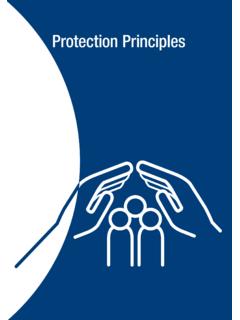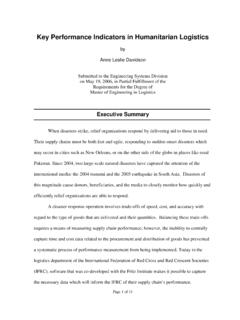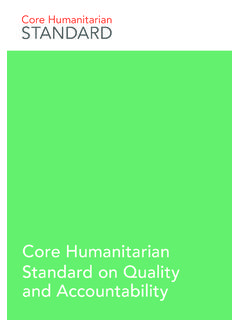Transcription of Minimum Standards in Health Action - Sphere …
1 Minimum Standards in Health Action humanitarian Charter and Minimum Standards in humanitarian Response How to use this chapter This chapter is divided into two main sections: Health systems Essential Health services A Health systems approach to the design, implementation, monitoring and evaluation of Health services is adopted as a framework for organising Health services during disaster response. This is the best approach to ensure that priority Health needs are identified and met in an efficient and effective manner. Principles such as supporting national and local Health systems, coordination and standardisation of tools and approaches are stressed throughout. The Protection Principles and Core Standards must be used consistently with this chapter. Although primarily intended to inform humanitarian response to a disaster, the Minimum Standards may also be considered during disaster preparedness. Each section contains the following: Minimum Standards : These are qualitative in nature and specify the Minimum levels to be attained in disaster response regarding the provision of Health services.
2 Key actions: These are suggested activities and inputs to help meet the Standards . Key indicators: These are signals' that show whether a standard has been attained. They provide a way of measuring and communicating the processes and results of key actions; they relate to the Minimum standard, not to the key Action . Guidance notes: These include specific points to consider when applying the Minimum stan- dards, key actions and key indicators in different situations. They provide guidance on tackling practical difficulties, benchmarks or advice on priority issues. They may also include critical issues relating to the Standards , actions or indicators, and describe dilemmas, controversies or gaps in current knowledge. If the required key actions and indicators cannot be met, the resulting adverse implications on the affected population should be appraised and appropriate mitigating actions taken. Appendices at the end of the chapter include a checklist for Health service assessments, sample surveillance reporting forms and formulas for calculating key Health indicators.
3 A references and further reading section is also provided. 288. Minimum Standards in Health Action Contents Introduction 291. 1. Health systems 296. 2. Essential Health services 309. Essential Health services control of communicable diseases 311. Essential Health services child Health 320. Essential Health services sexual and reproductive Health 325. Essential Health services injury 331. Essential Health services mental Health 333. Essential Health services non-communicable diseases 336. ealth assessment checklist 338. Appendix 1: H. Appendix 2: Sample weekly surveillance reporting forms 341. Appendix 3: F ormulas for calculating key Health indicators 346. References and further reading 348. 289. humanitarian Charter and Minimum Standards in humanitarian Response humanitarian Protection Core Charter Principles Standards Health Action Essential Health Health systems services Standard 1. Prioritising Health services Standard 1. Health service Control of Sexual and Non- delivery Mental communicable Child Health reproductive Injury communicable Health diseases Health diseases Standard 2 Standard 1 Standard 1 Standard 1 Standard 1 Standard 1 Standard 1.
4 Human Communicable Prevention of Reproductive Injury care Mental Health Non- resources disease vaccine- Health communicable prevention preventable diseases diseases Standard 3 Standard 2 Standard 2 Standard 2. Drugs and Communicable Management HIV and AIDS. medical diseases of newborn diagnosis supplies and case and childhood management illness Standard 4 Standard 3. Health Outbreak financing detection and response Standard 5. Health information management Standard 6. Leadership and coordination Appendix 1: Health assessment checklist Appendix 2: Sample weekly surveillance reporting forms Appendix 3: Formulas for calculating key Health indicators References and further reading 290. Minimum Standards in Health Action Introduction Links to the humanitarian Charter and international law The Minimum Standards in Health Action are a practical expression of the shared beliefs and commitments of humanitarian agencies and the common principles, rights and duties governing humanitarian Action that are set out in the humanitarian Charter.
5 Founded on the principle of humanity, and reflected in international law, these principles include the right to life with dignity, the right to protection and security, and the right to receive humanitarian assistance on the basis of need. A list of key legal and policy docu ments that inform the humanitarian Charter is available for reference in Annex 1 (see page 356), with explanatory comments for humanitarian workers. Although states are the main duty-bearers with respect to the rights set out above, humanitarian agencies have a responsibility to work with disaster-affected populations in a way that is consistent with these rights. From these general rights flow a number of more specific entitlements. These include the rights to participation, information and non-discrimination, as well the specific rights to water, food, shelter and Health that underpin these and the Minimum Standards in this Handbook. Everyone has the right to Health , as enshrined in a number of international legal instruments.
6 The right to Health can be assured only if the population is protected, if the professionals responsible for the Health system are well trained and committed to universal ethical principles and professional Standards , if the system in which they work is designed to meet Minimum Standards of need, and if the state is willing and able to establish and secure these conditions of safety and stability. In times of armed conflict, civilian hospitals and medical facilities may in no circumstances be the object of attack, and Health and medical staff have the right to be protected. The carrying-out of acts or activities that jeop- ardise the neutrality of Health facilities, such as carrying arms, is prohibited. The Minimum Standards in this chapter are not a full expression of the right to Health . However, the Sphere Standards reflect the core content of the right to Health , especially during emergencies, and contribute to the progressive realisa- tion of this right globally.
7 291. humanitarian Charter and Minimum Standards in humanitarian Response The importance of Health Action in disasters Access to healthcare is a critical determinant for survival in the initial stages of disaster. Disasters almost always have significant impacts on the public Health and well-being of affected populations. The public Health impacts may be described as direct ( death from violence and injury) or indirect ( increased rates of infectious diseases and/or malnutrition). These indirect Health impacts are usually related to factors such as inadequate quantity and quality of water, breakdowns in sanitation, disruption of or reduced access to Health services and deterioration of food security. Lack of security, movement constraints, population displacement and worsened living conditions (overcrowding and inadequate shelter) can also pose public Health threats. Climate change is potentially increasing vulnerability and risk. The primary goals of humanitarian response to humanitarian crises are to prevent and reduce excess mortality and morbidity.
8 The main aim is to maintain the crude mortality rate (CMR) and under-5 mortality rate (U5MR) at, or reduce to, less than double the baseline rate documented for the population prior to the disaster (see table on baseline reference mortality data by region on page 311). Different types of disaster are associated with differing scales and patterns of mortality and morbidity (see table on public Health impact of selected disasters opposite), and the Health needs of an affected population will therefore vary according to the type and extent of the disaster. The contribution from the Health sector is to provide essential Health services, including preventive and promotive interventions that are effective in reducing Health risks. Essential Health services are priority Health interventions that are effective in addressing the major causes of excess mortality and morbidity. The implementation of essential Health services must be supported by actions to strengthen the Health system.
9 The way Health interventions are planned, organ- ised and delivered in response to a disaster can either enhance or undermine the existing Health systems and their future recovery and development. An analysis of the existing Health system is needed to determine the system's level of performance and to identify the major constraints to the delivery of, and access to, Health services. In the early stages of a disaster, information may be incomplete and important public Health decisions may have to be made without all of the relevant data being available. A multi-sectoral assessment should be conducted as soon as possible (see Core Standard 3 on page 61). Better response is achieved through better preparedness. Preparedness is based on an analysis of risks and is well linked to early warning systems. Preparedness 292. Minimum Standards in Health Action includes contingency planning, stockpiling of equipment and supplies, establish- ment and/or maintenance of emergency services and stand-by arrangements, communications, information management and coordination arrangements, personnel training, community-level planning, drills and exercises.
10 The enforce- ment of building codes can dramatically reduce the number of deaths and serious injuries associated with earthquakes and/or ensure that Health facilities remain functional after disasters. Public Health impact of selected disasters NB: Even for specific types of disaster, the patterns of morbidity and mortality vary significantly from context to context. Effect Complex Earthquakes High Floods Flash emergencies winds floods/. (without tsunamis flooding). Deaths Many Many Few Few Many Severe injuries Varies Many Moderate Few Few Increased High Varies* Small Varies* Varies*. risk of communicable diseases Food scarcity Common Rare Rare Varies Common Major Common Rare Rare Common Varies population (may occur (may occur displacements in heavily in heavily damaged damaged urban areas) urban areas). * Depends on post-disaster displacement and living conditions of the population Source: Adapted from Pan American Health Organization, 2000.













